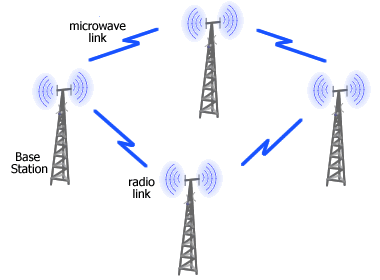Networking Guide : Physical Media - Wireless
Radio frequency (RF) refers to
frequencies of radio waves. RF is part of electromagnetic spectrum that
ranges from 3 Hz - 300 GHz. Radio wave is radiated by an antenna and produced by alternating currents
fed to the antenna. RF is used in many standard as well as proprietary wireless communication systems.
RF has long been used for radio and TV broadcasting, wireless local loop, mobile communications, and amateur radio.

Picture: Radio waves radiated by a Base Station's antenna
Microwave is the upper part of RF spectrum, i.e. those frequencies above 1 GHz.
Because of the availability of larger bandwidth in microwave
spectrum, microwave is used in many applications such as
wireless PAN (Bluetooth), wireless LAN (Wi-Fi), broadband wireless access
or wireless MAN (WiMAX), wireless WAN (2G/3G cellular networks),
satellite communications and radar. But it became a household name because of its use in microwave oven.

Picture:
Microwave is used in satellite communication.
Infrared light is part of electromagnetic spectrum
that is shorter than radio waves but longer than visible light.
Its frequency range is between 300 GHz and 400 THz, that corresponds to wavelength
from 1mm to 750 nm. Infrared has long been used in night vision
equipment and TV remote control. Infrared is also one of the
physical media in the original wireless LAN standard, that's IEEE
802.11. Infrared use in communication and networking was defined by
the IrDA (Infrared Data Association). Using
IrDA specifications, infrared can be used in a wide range of
applications, e.g. file transfer, synchronization, dial-up
networking, and payment. However, IrDA is limited in range (up to
about 1 meter). It also requires the communicating devices to be in
LOS and within its
30-degree beam-cone.

Picture: TV remote control uses infrared.
|